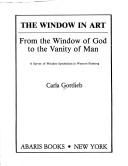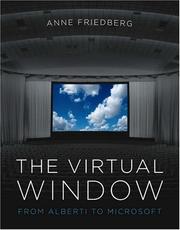| Listing 1 - 5 of 5 |
Sort by
|
Book
ISBN: 9783496014096 Year: 2010 Publisher: Berlin Dietrich Reimer Verlag
Abstract | Keywords | Export | Availability | Bookmark
 Loading...
Loading...Choose an application
- Reference Manager
- EndNote
- RefWorks (Direct export to RefWorks)
Windows in art. --- Windows in literature. --- Windows in art --- Windows in literature
Book
ISBN: 2848678828 2848676612 9782848676616 Year: 2019 Publisher: Besançon Presses universitaires de Franche-Comté
Abstract | Keywords | Export | Availability | Bookmark
 Loading...
Loading...Choose an application
- Reference Manager
- EndNote
- RefWorks (Direct export to RefWorks)
Objet transitionnel à deux sens, selon H. Lefebvre, la fenêtre laisse passer la lumière et l’air de l’extérieur tout en constituant un point d’observation du monde du dehors. La fenêtre revêt donc de multiples fonctions et matérialise également différentes symboliques, entre autres celles de l’intérieur et de l’extérieur, du public et du privé, de l’ouvert et du fermé. En tant que cadre, elle a exercé une influence majeure à la perception du paysage et, par extension, à la peinture. L’ouvrage réunit des études qui envisagent la fenêtre dans la littérature et les arts (peinture, photographie, théâtre, cinéma, architecture) par des approches esthétiques, sémiotiques, historiques et narratives.
Art --- art --- littérature --- architecture --- fenêtre --- cinéma --- Windows in art --- Windows in literature --- Literature --- History of civilization --- aesthetics --- theme --- windows
Book
ISBN: 9780300169775 9781588394132 0300169779 Year: 2011 Publisher: New York: New Haven: Metropolitan museum of art, Yale University press,
Abstract | Keywords | Export | Availability | Bookmark
 Loading...
Loading...Choose an application
- Reference Manager
- EndNote
- RefWorks (Direct export to RefWorks)
During the first half of the 19th century, the open window emerged as a consistent motif in German, Danish, French, and Russian painting and drawing. "Rooms with a View" is the first book to explore this intriguing theme in European art, with its Romantic intimations of unfulfilled longing and its associated qualities of poetry, luminosity, and interiority. Artists depicted this intangible mood with images of contemplative figures in hushed, sparsely furnished rooms; painters diligently at work in their studios; simple, serene displays of light entering a chamber; and windows as the focal point of views in their own right. "Rooms with a View" features forty oils and thirty works on paper by both well-known and largely undiscovered artists, including Caspar David Friedrich, Carl Gustav Carus, Georg Friedrich Kersting, Adolph Menzel, Christoffer Wilhelm Eckersberg, Martinus Rorbye, Jean Alaux, Leon Cogniet, and Fyodor Petrovich Tolstoy.
Painting --- anno 1800-1899 --- raam --- open raam --- vergezichten --- ateliers --- stadsgezichten --- landschappen --- Friedrich, Caspar David --- Menzel, Adolph Friedrich Erdmann --- 19de eeuw --- Windows in art --- Art, European --- atelier --- Windows in art - Exhibitions. --- Art, European - 19th century - Exhibitions. --- raam. --- open raam. --- vergezichten. --- atelier. --- stadsgezichten. --- landschappen. --- Friedrich, Caspar David. --- Menzel, Adolph Friedrich Erdmann. --- 19de eeuw.

ISBN: 0913870404 Year: 1981 Publisher: New York, N.Y. Abaris
Abstract | Keywords | Export | Availability | Bookmark
 Loading...
Loading...Choose an application
- Reference Manager
- EndNote
- RefWorks (Direct export to RefWorks)
Christian art and symbolism. --- Windows in art --- Windows --- Art, Christian --- Art, Ecclesiastical --- Arts in the church --- Christian symbolism --- Ecclesiastical art --- Symbolism and Christian art --- Religious art --- Symbolism --- Symbolism in art --- Church decoration and ornament --- Religious aspects --- Iconography --- Painting --- Europe --- Christian art and symbolism

ISBN: 9780262512503 9780262062527 0262512505 Year: 2009 Publisher: Cambridge, MA.: MIT Press,
Abstract | Keywords | Export | Availability | Bookmark
 Loading...
Loading...Choose an application
- Reference Manager
- EndNote
- RefWorks (Direct export to RefWorks)
As we spend more time staring at TVs and computers - 'windows' full of moving images, texts, and icons - how the world is framed has become as important as what is in the frame. This book examines the window as metaphor, as architectural component, and as an opening to the dematerialised reality seen on the screen. In De pictura (1435), Leon Battista Alberti famously instructed painters to consider the frame of the painting as an open window. Taking Alberti's metaphor as her starting point, Friedberg tracks shifts in the perspectival paradigm as she gives us histories of the architectural window, developments in glass and transparency, and the emerging apparatuses of photography, cinema, television, and digital imaging. Single-point perspective—Alberti's metaphorical window—has long been challenged by modern painting, modern architecture, and moving-image technologies. And yet, notes Friedberg, for most of the twentieth century the dominant form of the moving image was a single image in a single frame. The fractured modernism exemplified by cubist painting, for example, remained largely confined to experimental, avant-garde work. On the computer screen, however, where multiple 'windows' coexist and overlap, perspective may have met its end. In this wide-ranging book, Friedberg considers such topics as the framed view of the camera obscura, Le Corbusier's mandates for the architectural window, Eisenstein's opinions on the shape of the movie screen, and the multiple images and nested windows commonly displayed on screens today. The Virtual Window proposes a new logic of visuality, framed and virtual: an architecture not only of space but of time.
Image (Philosophy) --- Mass media --- Fenster (Motiv) --- History --- Philosophy --- Alberti, Leon Battista, --- Bergson, Henri, --- Descartes, René, --- Heidegger, Martin, --- Virilio, Paul, --- History. --- Philosophy and psychology of culture --- Mass communications --- Windows --- Windows in art --- Windows (Computer programs) --- Windowing (Computer programs) --- Graphical user interfaces (Computer systems) --- Utilities (Computer programs) --- Architecture --- Building --- Glazing --- Mass communication --- Media, Mass --- Media, The --- Communication --- Philosophy&delete& --- Details --- #SBIB:309H520 --- #SBIB:39A8 --- #SBIB:316.7C200 --- Audiovisuele communicatie: algemene werken --- Antropologie: linguïstiek, audiovisuele cultuur, antropologie van media en representatie --- Sociologie van de cultuuruitingen: algemeen --- Image (Philosophy) - History --- Mass media - Philosophy - History --- Alberti, Leon Battista, - 1404-1472 --- Bergson, Henri, - 1859-1941 --- Descartes, René, - 1596-1650 --- Heidegger, Martin, - 1889-1976 --- Virilio, Paul, - 1932 --- -Image (Philosophy) --- Virilio, Paul, - 1932-
| Listing 1 - 5 of 5 |
Sort by
|

 Search
Search Feedback
Feedback About UniCat
About UniCat  Help
Help News
News